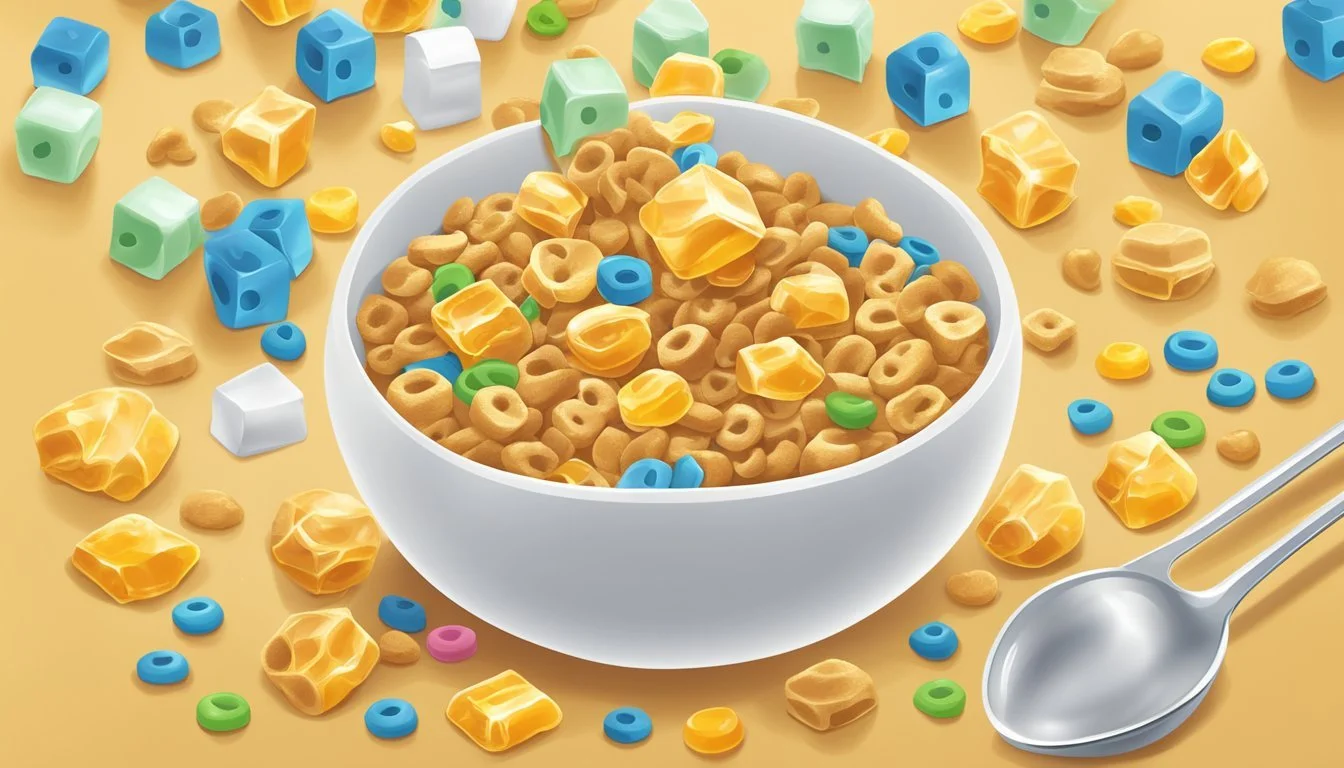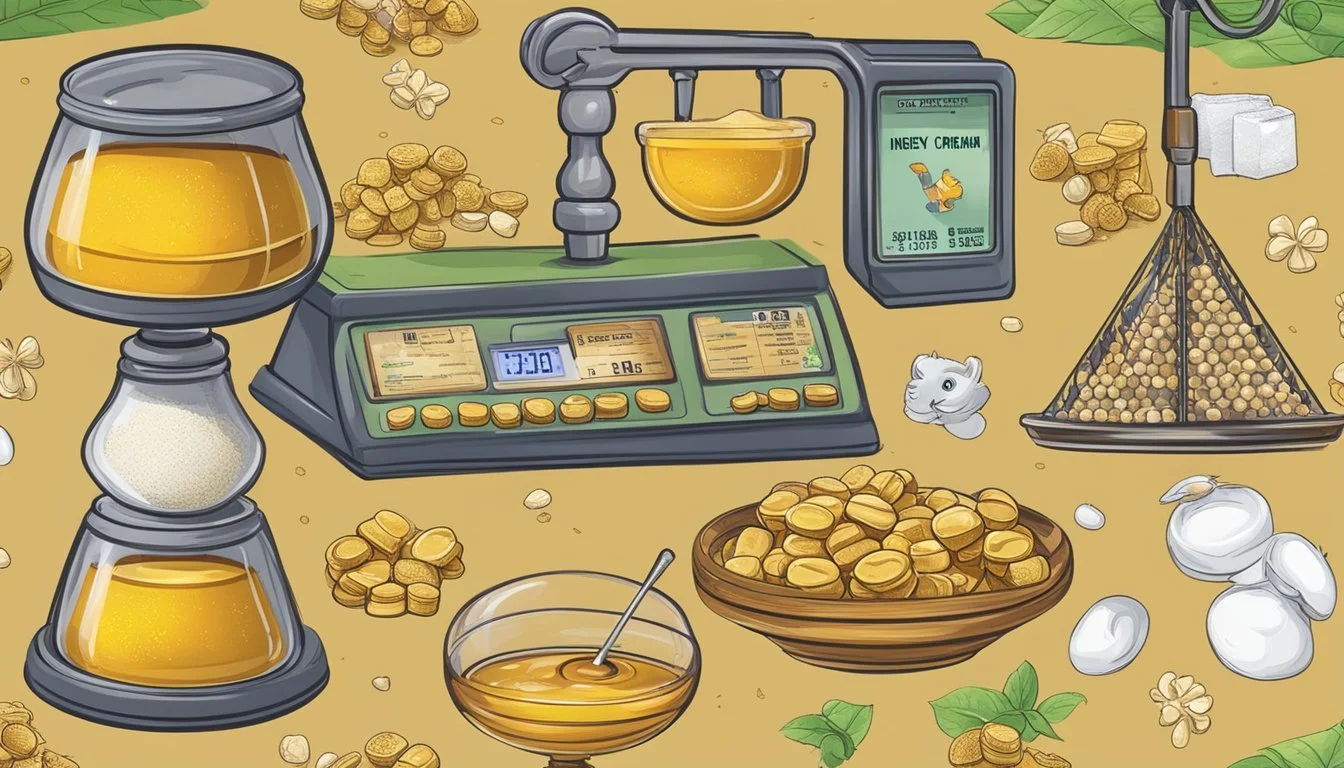Honey Ohs! vs Lucky Charms
Breakfast Cereal Showdown
This Article is Part of Our Breakfast Cereal Guide with Details on Honey Ohs! Nutrition and Lucky Charms Nutrition
When it comes to breakfast cereals, both Honey Ohs! and Lucky Charms have cultivated loyal followings with their unique flavors and textures. Honey Ohs! by Quaker Oats is generally recognized for its honey-flavored sweetness and crunchy oat circles. On the other hand, Lucky Charms, a product of General Mills, is famed for its colorful marshmallow pieces that add a playful twist to the traditional cereal experience.
Nutritional value varies between these two popular options. Honey Ohs! typically offers higher fiber content, beneficial for digestive health. Lucky Charms, while lower in fiber, is fortified with a broader range of vitamins and minerals, including vitamin D, which can support bone health.
Ultimately, the choice between Honey Ohs! and Lucky Charms boils down to personal preference and nutritional priorities. Those seeking a fiber-rich start to their day might lean towards Honey Ohs!, while those who enjoy a more whimsical, fortified cereal experience might find Lucky Charms more appealing. Whichever you choose, both cereals provide unique benefits to kickstart your morning.
Cereal Origins and Manufacturers
Both Honey Ohs! and Lucky Charms have rich histories tied to their manufacturers, with unique developments that highlight their place in the cereal industry.
History of Honey Ohs!
Honey Ohs! is a breakfast cereal developed by Quaker Oats. The cereal was first introduced in the mid-1980s. Known for its honey-flavored oat rings filled with crunchy nuts and graham clusters, Honey Ohs! has built a dedicated following.
Initially, Quaker Oats focused on marketing Honey Ohs! as a wholesome and tasty breakfast option. Over the years, the recipe has seen minor tweaks but has largely maintained its original flavor and texture.
Evolution of Lucky Charms
Lucky Charms, produced by General Mills, hit supermarket shelves in the mid-1960s. It was the first cereal to include marshmallows, creating a unique appeal. The brand's mascots, Lucky the Leprechaun, and its iconic marshmallow shapes—hearts, moons, stars, and clovers—have become cultural symbols.
Lucky Charms' recipe has evolved, adding various marshmallow shapes and limited-time promotional items. The essence of the cereal remains, blending oat pieces with its characteristic "marbits."
General Mills also manufactures Honey Nut Cheerios, another popular cereal. The company consistently innovates to keep its products appealing to both new and loyal consumers.
Nutritional Profiles
Both Honey Ohs! and Lucky Charms offer unique nutritional benefits and considerations for consumers. Key differences include sugar content, fiber, and essential vitamins.
Comparison of Key Nutrients
Calories per Serving:
Honey Ohs! and Lucky Charms both fit within a 110-140 calorie range per serving.
Grams of Sugars per Serving:
Lucky Charms contains 12 grams of sugar, while Honey Ohs! has a comparable amount, often fluctuating around 9 grams per serving.
Grams of Fat per Serving:
Lucky Charms offers 1 gram of fat per serving. Honey Ohs! typically matches this with 1 gram as well.
Milligrams of Sodium per Serving:
Honey Ohs! contains 220 milligrams of sodium, surpassing Lucky Charms which has 180 milligrams.
Grams of Dietary Fiber per Serving:
Honey Ohs! provides 1 gram of dietary fiber per serving, whereas Lucky Charms exceeds it slightly with up to 2 grams.
Serving Size and Dietary Recommendations
Nutritional values are typically based on serving sizes of 1 cup for both cereals.
Daily Recommendations:
For an average adult diet of 2000 calories:
Calories: Each serving of either cereal represents about 5-7% of daily caloric intake.
Sugar: The high sugar content in both cereals makes them occasional treats rather than daily staples.
Fiber: Both cereals fall short in meeting the recommended daily fiber intake, so they should be paired with fiber-rich fruits to enhance dietary benefits.
Vitamins and Minerals:
Lucky Charms is fortified with a broader spectrum of vitamins and minerals, including Vitamin D, Iron, and B vitamins, offering higher daily value percentages. Honey Ohs! also offer essential nutrients but on a more limited scale.
Whole Grain Content:
Evaluating the whole grain content can further aid in making a healthier choice, although both cereals offer some whole grains. Adding additional whole grains can be beneficial for a balanced diet.
Ingredient Analysis
Both Honey Ohs! and Lucky Charms have distinct ingredients that target different consumer preferences, from sweet flavors to nutritional benefits. This section will compare their core ingredients and examine the additives and potential health implications.
Core Ingredients Breakdown
Honey Ohs! contains whole grain oats, cane sugar, corn syrup, and almonds. The inclusion of whole grain oats provides a source of dietary fiber. Cane sugar and corn syrup contribute to the cereal's sweet taste, which may appeal to those preferring natural sweeteners. The almonds add a nutty texture and provide additional nutrients, such as healthy fats and protein.
Lucky Charms features whole grain oats, sugar, corn syrup, and gelatin. Additionally, it contains its iconic marshmallows, made from sugar, corn syrup, modified corn starch, and dextrose. These ingredients create its unique texture and flavor profile. Lucky Charms includes a higher sugar content in its marshmallows, contributing to its overall sweet taste. Vitamin B12 is also often added for nutritional benefits.
Additives and Health Implications
Honey Ohs! tends to use fewer synthetic colors and preservatives. The brand focuses on natural ingredients, making it a preferable choice for those looking to minimize artificial additives. It avoids hydrogenated oils, which are known to contribute to heart risks. Most ingredients in Honey Ohs! are more natural, potentially making it a healthier option.
Lucky Charms includes various artificial colors (Yellow 5, Blue 1), flavorings, and preservatives. These dyes can be a concern for parents or anyone cautious about synthetic additives. Though gluten-free, Lucky Charms relies heavily on artificial sweeteners and colors to maintain their appeal, possibly impacting long-term health. Nonetheless, the inclusion of fortified nutrients like Vitamin B12 can offer some nutritional benefits.
Honey Ohs! positions itself as a more nature-conscious option. At the same time, Lucky Charms emphasizes taste and nostalgia, leveraging a mix of ingredients designed for sensory appeal.
Taste and Texture Experience
Honey Ohs! and Lucky Charms offer distinct taste profiles and textures, appealing to different taste preferences. Both cereals bring unique flavors and mouthfeels to the table.
Flavor Comparisons
Honey Ohs! delivers a sweet honey flavor, which is rich and comforting. Each bite offers a consistent taste of honey, making it a favorite for those who enjoy a natural sweetness in their cereal.
Lucky Charms, on the other hand, boasts a more varied flavor profile. The oaty base cereal pieces are subtly sweet, but the standout is the colorful marshmallows. These marshmallows add bursts of sugary sweetness and a slight artificial taste, enhancing the cereal's overall sweetness.
The diversity in flavors between the two cereals makes for a distinct taste experience. Those preferring a milder, more singular honey flavor may gravitate towards Honey Ohs!. In contrast, those seeking a mix of oaty crunch and sugary bursts might find Lucky Charms more appealing.
Texture Analysis
When it comes to texture, Honey Ohs! and Lucky Charms differ significantly. Honey Ohs! features a crunchy and dense texture. Each piece is firm and holds its crispness well in milk, providing a satisfying bite with each spoonful.
Lucky Charms is known for its contrast in textures. The oat cereal pieces are light and crunchy, but the marshmallows offer a soft and slightly powdery texture. This mix creates a dynamic mouthfeel as the crunchy base contrasts with the melt-in-your-mouth marshmallow pieces.
Personal preferences play a crucial role. Consumers who enjoy a uniformly crunchy cereal might prefer Honey Ohs!. Meanwhile, those who enjoy varying textures in their bowl will likely enjoy the experience that Lucky Charms offers.
Consumer Choices and Preferences
Different markets and demographics exhibit unique preferences when choosing between Honey Ohs! and Lucky Charms. Factors like age, health considerations, and the appeal of the products play significant roles.
Market Trends
Recent trends indicate a growing demand for healthier breakfast options. Honey Ohs! is perceived as a healthier choice due to its lower sugar content and the presence of whole grains.
Lucky Charms, with its vibrant marshmallows, remains immensely popular among children.
The nutritional information for each cereal influences consumer decisions significantly. A comparison shows that Honey Ohs! typically offers lower sugar per serving than Lucky Charms.
However, fortified cereals like Lucky Charms, which contain vitamins such as Vitamin D, also attract health-conscious consumers seeking added nutrients.
Demographic Preferences
Children and younger consumers frequently prefer Lucky Charms due to its colorful and whimsical appearance. The inclusion of marshmallows adds a fun and engaging element to their breakfast.
Adults and those seeking a healthier option often lean toward Honey Ohs!.
The emphasis on whole grains and a balanced nutritional profile makes Honey Ohs! more appealing for those prioritizing health. Parents looking for a healthier breakfast choice for their kids may also favor Honey Ohs!.
Serving sizes and the presentation of the cereals can sway consumer preferences. Lucky Charms' playful shapes and colors are distinct attractions for a younger demographic, whereas Honey Ohs!' straightforward approach appeals to those seeking simplicity and nutritional value.
Branding and Marketing
Honey Ohs! and Lucky Charms adopt distinct branding and marketing strategies to appeal to their respective audiences. These tactics significantly influence their brand loyalty and market impact.
Advertising Strategies
Lucky Charms employs vibrant and whimsical advertisements featuring their iconic mascot, Lucky the Leprechaun. Their campaigns often emphasize the cereal's playful nature and "magically delicious" marshmallows. TV commercials, social media, and interactive online content drive engagement with young audiences.
Honey Ohs! leverages nostalgia alongside a more straightforward appeal. They stress the blend of honey and graham flavors in their marketing. Print ads, grocery store displays, and family-oriented content highlight the cereal's taste and simplicity.
Both brands use distinct messaging to target different demographics effectively.
Brand Loyalty and Impact
Lucky Charms enjoys a strong fanbase, thanks to its long-standing presence since the mid-1960s. The cereal's unique marshmallow shapes foster emotional connections with consumers. This loyalty is reflected in the cereal’s enduring popularity and high cereal rating in various publications.
Honey Ohs!, while less iconic, focuses on quality and tradition to build loyalty. Their simple, wholesome image resonates with older consumers and health-conscious families.
Leveraging consistent messaging and product quality, both brands maintain a significant impact in the competitive cereal market.
Pricing and Accessibility
When comparing Honey Ohs! and Lucky Charms, it's important to consider both the price and the availability of these cereals. Pricing varies based on packaging size and location, while availability can influence purchasing decisions.
Cost Comparison
Honey Ohs! and Lucky Charms differ in price depending on the box size and store. For example, a typical 18.6oz box of Lucky Charms is priced around $3.98, translating to 21.4¢ per ounce. In comparison, there may be variations in the cost of Honey Ohs! based on sales and retailer pricing strategies.
A larger 29.1oz box of Lucky Charms costs about $5.48, or 18.9¢ per ounce, offering better value per unit weight. Consumers should also consider store-specific promotions and bulk buying options, which can significantly affect the per-ounce cost.
Availability in Markets
Honey Ohs! and Lucky Charms are both widely available, but there may be differences in distribution. Lucky Charms enjoy extensive shelf space in major grocery chains, big-box stores, and online retailers, ensuring easy access for most consumers.
Honey Ohs! might have more limited availability, depending on the retailer. However, it is often found in popular grocery chains and online platforms. The wide availability of both brands allows consumers to compare prices and choose the most convenient purchasing option based on their geographical location.
Regulatory and Certification Standards
Honey Ohs! and Lucky Charms both adhere to stringent regulatory and certification standards to ensure product safety and nutritional transparency.
Health and Safety Certifications
Both Honey Ohs! and Lucky Charms are subject to FDA regulations aimed at maintaining high standards for food safety. These cereals must comply with guidelines that detail the acceptable levels of various ingredients, contaminants, and allergens.
Honey Ohs! may also feature certifications like gluten-free or organic if they meet specific criteria. For instance, an organic label indicates adherence to organic farming practices and no use of synthetic pesticides.
Lucky Charms, on the other hand, often touts its gluten-free certification, appealing to consumers with gluten sensitivities or celiac disease. This certification ensures that the product contains less than 20 parts per million of gluten, making it safe for those who require a gluten-free diet.
Nutritional Labeling
The nutritional labeling on Honey Ohs! and Lucky Charms is governed by FDA guidelines, which mandate clear and accurate information on calorie count, serving size, and nutrient content. This labeling helps consumers make informed dietary choices.
Honey Ohs! contains 1 gram of fat and 220 milligrams of sodium per serving. It also includes 1.0 grams of dietary fiber, which is crucial for digestive health.
In comparison, Lucky Charms has 1 gram of fat and 180 milligrams of sodium per serving. The dietary fiber content is similar, ensuring both cereals provide a modest amount of fiber per serving.
Both cereals must clearly list ingredients, serving sizes, and nutritional values, ensuring transparency and aiding in better consumer decision-making.
Environmental and Ethical Considerations
When comparing Honey Ohs! and Lucky Charms, it's important to assess their environmental impact and the ethical sourcing of their ingredients. These factors can influence consumer choices, especially for those concerned with sustainability and ethical practices.
Sustainable Practices
Sustainable practices in cereal production include the use of organic ingredients and minimal use of preservatives. Lucky Charms contains oats, a crop known for its soil benefits. When oats are planted as a cover crop, they help improve soil health and reduce erosion. This can make Lucky Charms a more environmentally friendly option based solely on its primary ingredients.
Honey Ohs! by Quaker Oats has not been highlighted for specific sustainable farming practices in recent reports. It’s essential to consider if the cereal uses organic or natural ingredients which have a smaller carbon footprint due to fewer synthetic pesticides and fertilizers.
Ethical Sourcing of Ingredients
Ethical sourcing involves transparency, fair trade, and protection of biodiversity. Lucky Charms, produced by General Mills, uses oats which can be part of ethical sourcing when grown as per fair trade guidelines. This means paying farmers fairly and ensuring good labor practices. The incorporation of oats also supports diversified farming, which is beneficial for ecosystems.
Honey Ohs! should be evaluated by the ethically sourced ingredients it uses. For example, if the honey incorporated is Fairtrade certified, it ensures that beekeepers are paid fairly and that sustainable beekeeping practices are followed. This is significant as ethical honey sources protect bee colonies essential for pollination and biodiversity.
In summary, both cereals offer different strengths in terms of sustainability and ethical sourcing, and these aspects can be a deciding factor for informed consumers.
Conclusion and Recommendations
Choosing between Honey Ohs! and Lucky Charms depends on several factors, including personal preference and nutritional value.
Personal Preference:
Honey Ohs!: Known for its distinct honey flavor and satisfying crunch.
Lucky Charms: Celebrated for its combination of toasted oats and colorful marshmallows.
Healthier Option:
Honey Ohs!: Contains whole grain oats and essential nutrients.
Lucky Charms: Often criticized for its high sugar content, despite also using whole grains.
Nutritional Value Comparison:
Nutrient Honey Ohs! Lucky Charms Calories Lower Higher Sugars Lower Higher Fiber Higher Medium Protein Similar Similar
Personal choice plays a significant role in selecting a cereal. Some might prioritize the nostalgic taste of Lucky Charms, while others prefer the richer flavor profile of Honey Ohs!.
In terms of health, Honey Ohs! may be a better option due to its lower sugar content and higher fiber.
Each individual should consider their dietary needs and taste preferences when making a choice.
Combining taste and health considerations leads to a balanced decision that aligns with both nutrition goals and flavor enjoyment.











